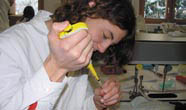| Tick Patrol HLFS Ursprung 2006 |
|
| Home | |
| Abstract | |
| Motivation | |
| Ticks | |
| The Hunt | |
| Laboratory Analysis | |
| Assignment | |
| Video | |
| Bibliography | |
| Team | |
| Imprint | |

![]()
 |
|
| We learned many new laboratory techniques, which can later be of use to us. |
 |
|
| Time, patience and curiousity helped us to succeed. |
 |
|
| The most sensitive steps are carried out in a so called laminar airflow cabinet. |
Bibliography
Journal of Clinical Microbiology.
2002 Oct;40(10):3802-4, Morozova OV, Dobrotvorsky AK, Livanova NN, Tkachev SE, Bakhvalova VN, Beklemishev AB, Cabello FC. “PCR detection of Borrelia burgdorferi sensu lato, tick-borne encephalitis virus, and the human granulocytic ehrlichiosis agent in Ixodes persulcatus ticks from Western Siberia, Russia.”
Clinical and Diagnostic Virology.
1995 Dec;4(4):321-6. Puchhammer-Stockl E, Kunz C, Mandl CW, Heinz FX. „Identification of tick-borne encephalitis virus ribonucleic acid in tick suspensions and in clinical specimens by a reverse transcription-nested polymerase chain reaction assay.”
Medical and Veterinary Entomology.
2001 Sep;15(3):304-13. Hudson PJ, Rizzoli A, Rosa R, Chemini C, Jones LD, Gould EA.“Tick-borne encephalitis virus in northern Italy: molecular analysis, relationships with density and seasonal dynamics of Ixodes ricinus.”
Journal of Clinical Microbiology
2001 May;39(5):1922-7. Scaramozzino N, Crance JM, Jouan A, DeBriel DA, Stoll F, Garin D“Comparison of flavivirus universal primer pairs and development of a rapid, highly sensitive heminested reverse transcription-PCR assay for detection of flaviviruses targeted to a conserved region of the NS5 gene sequences.”
Journal of Clinical Microbiology.
1999 Nov;37(11):3448-51. Baumgarten BU, Rollinghoff M, Bogdan C.“Prevalence of Borrelia burgdorferi and granulocytic and monocytic ehrlichiae in Ixodes ricinus ticks from southern Germany.”
Journal of Clinical Microbiology.
1997 Mar;35(3):685-90.Priem S, Rittig MG, Kamradt T, Burmester GR, Krause A.“An optimized PCR leads to rapid and highly sensitive detection of Borrelia burgdorferi in patients with Lyme borreliosis.”
Journal of Clinical Microbiology.
2004 May; 42(5): 2285–2286. Helene Polin,1* Peter Hufnagl,2 Reinhard Haunschmid,3 Florian Gruber,4 and Gunther Ladurner“Molecular Evidence of Anaplasma phagocytophilum in Ixodes ricinus Ticks and Wild Animals in Austria”
Journal of Clinical Virology.
2005, 33: 331–335Ana Saksida , Darja Duh, Stanka Lotri-Furlan , Franc Strle ,Miroslav Petrovec , Tatjana Avsic- Zupanc“The importance of tick-borne encephalitis virus RNA detection for early differential diagnosis of tick-borne encephalitis”
Vaccine,
2003, S1/36-S1/40Holzmann H“Diagnosis of tick-borne encephalitis”
Vaccine,
2003, S1/3-S1/10Heinz FX“Molecular aspects of TBE virus research”
Vaccine,
2003, S1/41-S1/49Noel Barret P, Schober-Bendixen S, Ehrlich HJ“History of TBE vaccines”
Vaccine,
2003, S1/50-S1/55Kunz C“TBE vaccination and the Austrian experience”
Bayerisches Landesamt für Arbeitsschutz, Arbeitsmedizin u. Sicherheitstechnik 2003 Kießling J, Stocker U, et.al„Aktuelle Daten zu zeckenübertragenen Zoonose-Erregern in Bayern“
„Infektionsepidemiologie zeckenübertragener Erkrankungen in Bayern“
H.Mehlhorn & G. Piekarski, Grundriß der Parasitenkunde. 1998, Gustav Fischer Verlag. 516 Seiten.
http://www.antibiotikamonitor.at/3_05/3_05_1.htm
Stanek G
„Lyme-/Schildzecken-Borreliose und andere Zecken-vermittelte Infektionskrankheiten in Österreich“
http://www.zecken.at/
http://www.zecken.de/
Selbsthilfegruppe Zeckenopfer 2004
„Borreliose, eine bakterielle Infektion durch die Zecke“
Baxter BioScience 2005
„Verbreitungsgebiete der FSME in Österreich“
„Management of Tick-borne Encephalitis“